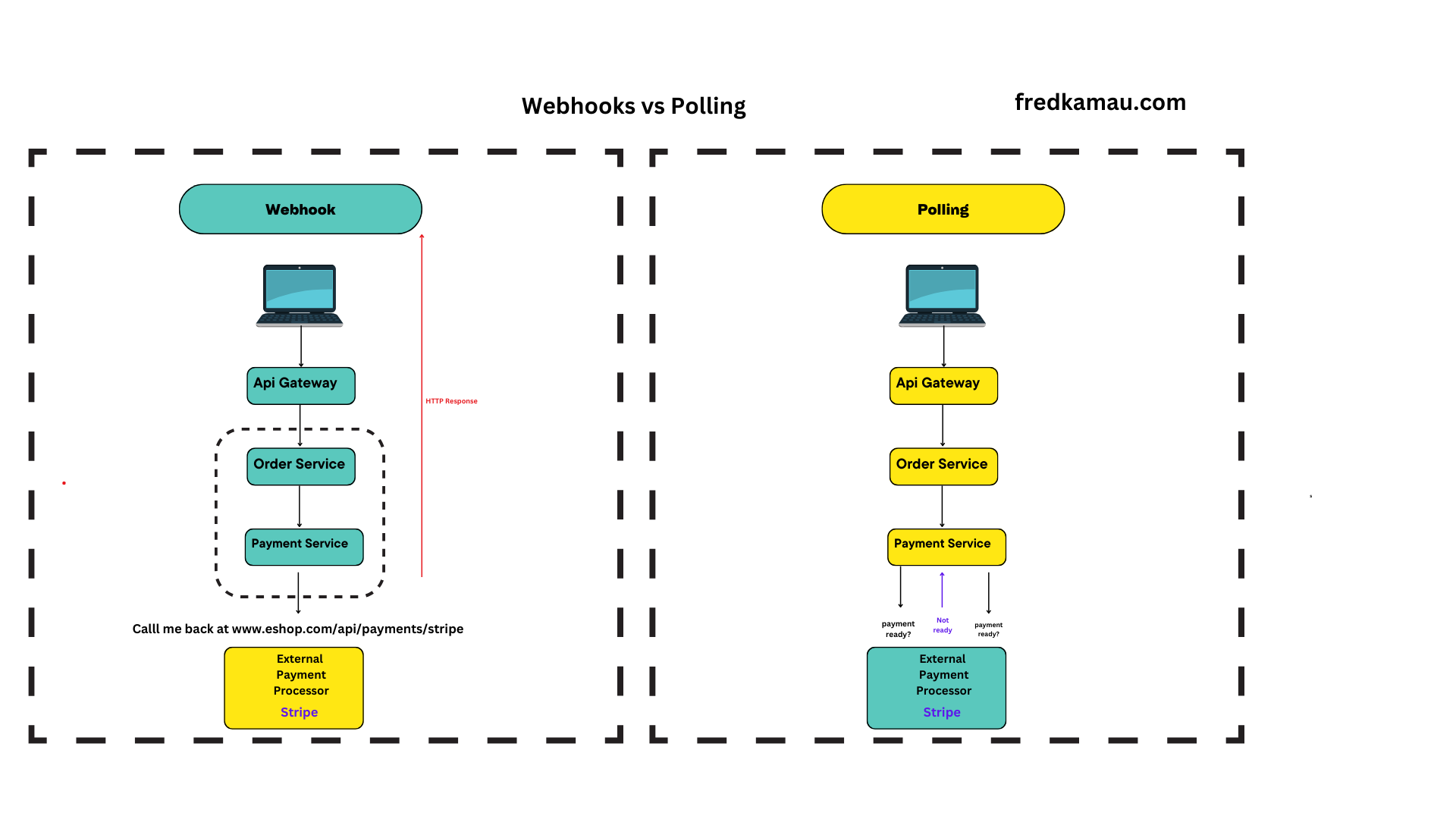Webhooks vs Polling
What’s the difference between Webhooks and Polling?
Real World Business Problem
Imagine an ecommerce store like Amazon where user submits an order which is handled by the order service which then goes to the payment service to handle payment transactions. The payment service talks to a payment service provider(PSP) like Stripe to complete the transaction. Stripe handles billions of requests per day, the communication between the payment service and Stripe should be asynchronous since it might take some time before the application get a response on the customer’s payment status. This can take a second, it can also take a minute or even an hour based on Stripe’s traffic. How does the application handle this? There are two ways to handle communications with the external PSP:
1. Polling
Polling is method where a client sends requests to a server at fixed intervals to check if new data is available.You can think of it as calling a restaurant every five minutes asking “Is my burger ready?”. Most of the time the response will be “No, not yet”. But after a few tries they will finally say, “Yes, your burger is ready, pick it up.” In our ecommerce application example, the Order Service will repeatedly ask the Payment Service “has the payment been processed?”. On the other hand the Payment Service will repeatedly ask External PSP “Is the payment confirmed?”. These services continue to send messages to each other at intervals, even when there is no update leading to unnecessary load.
Advantages.
i) Simplicity - It’s straightforward to implement and understand. ii) Control - The client has complete control to check updates at regular intervals, the behavior is predictable and can be fine-tuned for specific performance requirements. API polling can be as frequent as every minute or as infrequent as every 24 hours.
Disadvantage
i) Resource overhead / Wasteful - Constant polling can consume significant system resources including CPU cycles leading to inefficiency and power wastage. The vast majority of your API calls will return back data that hasn’t changed. ii) No real-time data - In most cases, you need to access and act on data in real time to realize the full potential value from it.
When to use Polling
i) Real-time updates are not critical.
ii) Webhooks are not supported by the server.
iii) The client operates in a restricted environment where incoming requests are not allowed.
2. Webhooks
A webhook is a push-based approach where the server notifies the client using a specified endpoint as soon as an event occurs. This method is more efficient than polling because it eliminates the need for repeated checking. In the example of ordering a burger, instead of calling repeatedly asking if the burger is ready, you can give the restaurant your phone number. When it’s ready, the restaurant will call you to pick it up. There is no need to waste time making unnecessary calls.
Using webhooks on the ecommerce application, the Order Service makes a one-time request to the Payment Service and waits. The Payment Service then contacts Stripe and set up a webhook (push/callback API). As soon as the payment transaction is complete it sends a notification to the Payment Service which notifies the Order Service. In this way, the programming paradigm is changed, and the payment service doesn’t need to waste resources to poll the payment status anymore.
Advantages
i) Real time updates - Webhooks can give near-instant notifications immediately the event occurs. A team can act on data in real time to realize the full potential value from it. ii) Efficiency - Eliminates the need to make unnecessary API calls, notifications will be sent when the event occurs. iii) Scalability - More scalable than polling, as the server only sends data when there are updates.
Disadvantages
i) Complexity - Setting up webhooks can be more complex than polling. It requires configuration and setup, the server must also support webhooks. ii) Security Concerns - Exposing an endpoint to receive notifications requires careful consideration of security implications and data validation. iii) Unreliable - you need a reliable way to handle webhook failures such as retries, background jobs and logging.
When to use webhooks
i) Real-time or near-real-time updates are necessary.
ii) The server and client infrastructure support outgoing and incoming requests, respectively.
iii) Reducing the load on the server and network is a priority.
Conclusion
In summary webhooks offer a more efficient and real-time approach to server-client communication. Polling is a viable alternative to implement in scenarios where webhooks support is unavailable. Choosing between the two depends on factors such as criticality of real-time data, application specific requirements and the capabilities of your infrastructure. Understanding these trade-offs ensures you build responsive, efficient, and scalable applications.
Thank You!
I’d love to keep in touch! Feel free to follow me on Twitter at @codewithfed. If you enjoyed this article please consider sponsoring this blog for more. Your feedback is welcome anytime. Thanks again!
